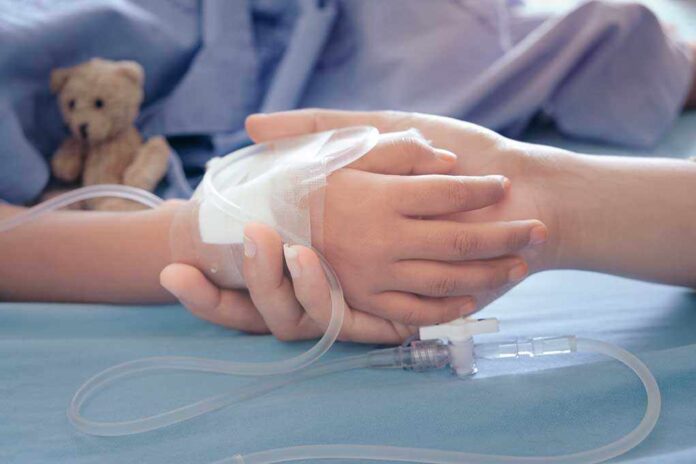Alcohol-related cancer deaths have doubled in America as government fails to warn citizens about the deadly risks that most Americans remain unaware of, even as thousands die annually.
Key Takeaways
- Alcohol-related cancer deaths in America have nearly doubled from under 12,000 in 1990 to over 23,000 in 2021, with men over 55 facing the highest increase.
- Only 45% of American adults are aware of the cancer risk associated with alcohol, compared to 89% awareness for tobacco, revealing a critical information gap.
- Alcohol is classified as a Group 1 carcinogen and is the third-leading preventable cause of cancer in the U.S., after tobacco and obesity.
- The District of Columbia and Texas have the highest rates of alcohol-linked cancer mortality, while Utah maintains the lowest rates nationwide.
- Experts recommend limiting alcohol consumption to reduce cancer risk, with current guidelines suggesting no more than one drink daily for women and two for men.
Silent Killer: Americans Unaware of Alcohol’s Cancer Link
A groundbreaking study from the Sylvester Comprehensive Cancer Center has revealed a disturbing trend in America’s health landscape. Alcohol-associated cancer fatalities have nearly doubled over three decades, rising from under 12,000 cases in 1990 to more than 23,000 by 2021. The research, focusing primarily on breast, liver, and colorectal cancers, exposes alcohol as a significant yet underrecognized contributor to cancer mortality nationwide. This represents approximately 5% of all cancer cases in America, creating an urgent public health concern.
The demographic patterns revealed in the study paint a concerning picture, particularly for older American men. While women have shown a slight decline in alcohol-related cancer deaths, men over 55 have experienced annual mortality increases exceeding 1% from 2007 to 2021. These figures reflect not only changing consumption patterns but also highlight demographic groups most vulnerable to alcohol’s carcinogenic effects. The regional variations across states further complicate this health crisis.
The Hidden Cancer Threat in Your Glass
Despite alcohol’s classification as a Group 1 carcinogen by leading health organizations, public awareness remains dangerously low. The study reveals that just 45% of American adults understand the cancer risks associated with alcohol consumption, compared to 89% who recognize tobacco’s dangers. This knowledge gap represents a critical failure in public health education, allowing millions to unknowingly increase their cancer risk through regular drinking habits. Alcohol now stands as America’s third-leading preventable cause of cancer, following only tobacco and obesity.
“That’s a big and concerning rise. We need to increase awareness of this link among the general population and even in the medical field. There’s a lot of awareness about, for example, tobacco and the risk of cancer. But for alcohol, that awareness isn’t there,” said Chinmay Jani, M.D.
The biological mechanisms linking alcohol to cancer are multifaceted and severe. When metabolized, alcohol produces acetaldehyde, a toxic compound that damages DNA and prevents repair. It also disrupts hormone regulation, particularly estrogen, explaining why one in six breast cancer cases is attributed to alcohol consumption. Additionally, alcohol interferes with nutrient absorption and often contributes to weight gain, which independently increases risk for thirteen cancer types. These combined effects make even moderate consumption potentially hazardous.
Regional Disparities and Prevention Strategies
The study reveals striking geographical differences in alcohol-related cancer mortality across America. The District of Columbia and Texas report the highest rates, while Utah maintains the lowest. These variations likely reflect distinct regional drinking cultures, socioeconomic factors, and disparities in healthcare access. Conservative states with strong religious influences typically show lower alcohol consumption rates and corresponding cancer deaths, highlighting the protective effect of cultural attitudes that discourage excessive drinking.
“We hope that our study will help educate the public on the impact of alcohol on individual cancer risk, as this is a potentially modifiable factor,” stated Gilberto Lopes, M.D.
Health experts recommend clear prevention strategies for Americans concerned about their cancer risk. The 2020-2025 Dietary Guidelines suggest limiting alcohol to one drink daily for women and two for men, though cancer specialists emphasize that no level of consumption is completely safe. Additional recommendations include quitting tobacco use, increasing vegetable and whole grain intake, reducing processed foods, maintaining healthy weight, and staying physically active. These combined approaches represent powerful tools for Americans to take control of their cancer risk.











